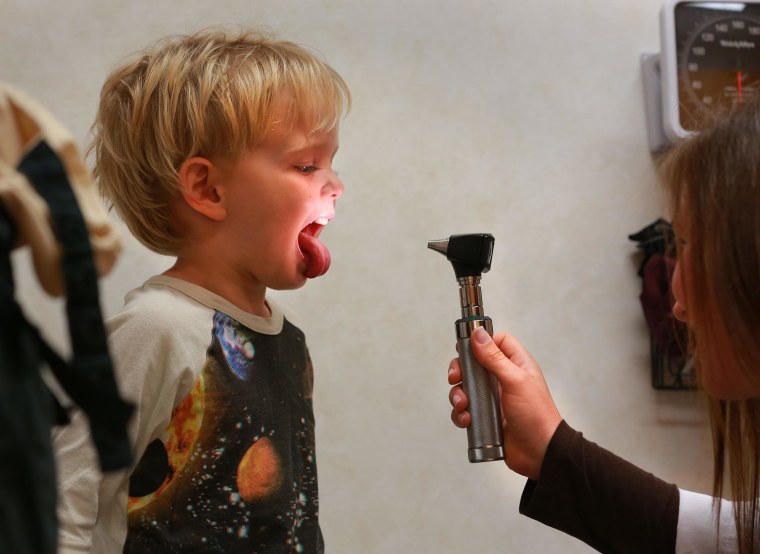People with sore throats, ear infections and sinus infections get the wrong antibiotic at least half the time, researchers reported Monday.
When people get the wrong antibiotic, not only are they often not cured, but it can help drug-resistant “superbugs” evolve, according to the researchers.

They think part of the problem is that patients ask for easy-to-remember names such as “Z-Pack” and the study found that azithromycin, the Zithromax drug that gives Z-Packs the name, is among the most commonly misused drugs.
“Overall, only 52 percent of patients treated with antibiotics for sinus infections, middle ear infections and pharyngitis (sore throat) received the first-line treatments recommended by prescribing guidelines,” Dr. David Hyun, an infectious disease specialist at the Pew Charitable Trusts, told NBC News.
This is on top of findings released earlier this year that show at least a third of people who get antibiotics don’t even need them. Taken together, the two studies show a lot of bad prescribing of antibiotics, the researchers wrote in the full report published in the Journal of the American Medical Association’s JAMA internal Medicine.
Related: Half of Antibiotic Prescriptions Are Just Wrong
The teams at Pew, the Centers for Disease Control and Prevention, the University of Utah and elsewhere chose ear infections, sore throats and sinus infections because they generate 44 million antibiotic prescriptions a year.
“Overall, only 52 percent of patients treated with antibiotics for sinus infections, middle ear infections, and pharyngitis received the first-line treatments recommended by prescribing guidelines."
It’s only appropriate sometimes to prescribe antibiotics for these conditions. Strep throat is easily treated with antibiotics, and if a child with a middle ear infection has pus oozing out, a pediatrician will usually give an antibiotic. Sinus infections that linger may be helped with antibiotics.
But more sore throats and ear infections are caused by viruses, and an antibiotic will do nothing to help the patient. Sinus infections can sometimes involve bacteria but often are caused by viruses or fungi.
When an antibiotic is called for, it should be a basic one — usually amoxicillin, the Pew team said. That’s not what people usually get, however.
“The most commonly prescribed non-first-line antibiotics for sinus infections, middle ear infections and pharyngitis were macrolides (such as azithromycin), a class of broad-spectrum antibiotics (which target a wide range of bacterial pathogens) frequently prescribed in outpatient settings,” the Pew team wrote in their report.
“However, macrolides are not recommended for sinus or middle ear infections and are recommended for pharyngitis only for patients with an allergy to the penicillin class of antibiotics.”
Related: Drug-Resistant Superbugs are a Substantial Threat
Why would doctors prescribe the wrong drug?
Patient demand is one reason, Hyun said. “We have seen studies that show doctor prescribing is influenced by those types of patient pressures and expectations for receiving antibiotics,” he said.
They may say something along the lines of “I got a Z-pack last time and I got better right away,” Hyun said. Doctors want to help, and they may just fold and give an easy-to-take Z-pack, which contains a set number of pills in a sleek package.
Azithromycin can sometimes work if taken for just three to five days, a shorter time than for amoxicillin, he added, which can also be appealing to both patients and to doctors worried that patients will stop taking their drug too soon.
Hyun said doctors may also incorrectly believe their patients want certain antibiotics. It’s important, he said, for doctors to explain why they are or are not prescribing a particular antibiotic.
In some cases, people may be allergic to penicillin — amoxicillin is a version of penicillin — but the researchers took this into account.
The good news is that most children with ear infections do get the right prescription. In a separate report in JAMA Internal Medicine, Dr. Adam Hersh of the University of Utah and colleagues found that 67 percent — two-thirds — of children with ear infections got the correct prescription. But only 37 percent of adults with sore throats and sinus infections did.
“This study provides evidence of substantial overuse of non–first-line antibiotics."
The teams used two big national surveys from 2010 and 2011, which they said were the latest available. “We do not have reason to believe practice patterns have substantially changed,” Hersh’s team wrote.
“This study provides evidence of substantial overuse of non–first-line antibiotics for three of the most common conditions in ambulatory care that collectively account for more than 40 million antibiotic prescriptions annually,” they concluded.
Medical experts have been complaining about the misuse of antibiotics for two decades, but the message still is not getting through, Hyun said.
His prescription: education, and more education. Patients also need to get tough on themselves and their doctors, he said. “They should ask, ‘Is an antibiotic really needed? Is this the correct antibiotic?’” he said.
The CDC says more than 2 million people are infected by drug-resistant germs each year, and 23,000 die of their infections

